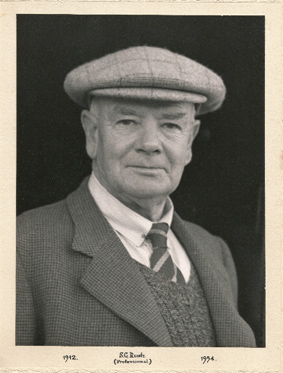Samuel George Rush, known by all as Sid, was born in Felixstowe in 1887. At the age of fourteen, on 7th May 1887, he was employed as a golf caddy. By 1911 Sid was living with his brother William’s family in Cromer. William was a golf club-maker and Sid worked for him. By the outbreak of war, Sid was living at Holly Cottages on Melton Road and working as a Golf Professional at Woodbridge Golf Club. Sid enlisted in Saxmundham on 30th November 1914 and joined the 6th (Cyclists) Battalion, Suffolk Regiment, who were a territorial battalion, raised by local businessman and Melton resident, William Tertius Pretty, in 1908. They had groups in Wickham Market, Corton near Lowestoft, Southwold, and Leiston.
On 26th July 1916, Sid was posted to France with thirty-nine other men from the 2/6th Suffolk Cyclists Regiment. They joined the 2nd Battalion Suffolk Regiment on the Somme at Sandpits Camp, near Méaulte, on the 12th August. Two days after arrival, Sid had his first experience of the trenches, and on the 16th August, he took part in an attack on Cochrane Alley near Maltz Horn Farm.
In November, the 2nd Suffolks were in the Serre area of the Somme when they were ordered to take a German trench as part of the Battle of Ancre. The History of the Suffolk Regiment 1914-1927 by Lieutenant Colonel C C R Murphy describes the events of the 13th as follows:
“At 5:00 am on November 13th, the first wave floundered forward into No Man’s Land – in reality, a sea of mud in which movement was barely possible. Three-quarters of an hour later the attack began. The mist which hung about the low ground thickened as the smoke of the barrage increased, making direction extremely difficult to maintain. Within a very short time all the officers of the leading companies had fallen, and owing to lack of leaders no real progress was made. In spite of the atrocious weather conditions prevailing, portions of the Suffolk companies actually reached the German second line. But all was in vain, and the battalion having been re-organised in its original front line remained there for the rest of the day.”
Once the battalion had returned to their billets the following day, eleven officers and two hundred and sixty-one other ranks were reported as casualties having been killed, wounded or reported missing.
Sid Rush was one of the men missing. He had received shrapnel wounds to his back and had been taken prisoner by the Germans. It was not until the 14th December that Sid’s wife Elsa, whom he had married in 1914, was informed he was missing. On 24th January, news was received that Sid was a prisoner in Giessen Prisoner of War Camp in Germany. He would remain there for the rest of the war.
Sid arrived back in Dover, with a party of repatriated prisoners, on the 10th December 1918. He was discharged on 13th April 1919, when he returned home to Holly Cottage in Melton. For his war service, Sid received the British War and Victory medals, and he received the Silver War Badge as a result of the injuries he received. Sid and Elsa had one child, a son named Philip. In 1939, the family was living at Park Villa on Melton Road and Sid was listed as being a Professional Golfer and Club Maker. He held the position of Golf Professional at Woodbridge Golf Club from 1912 until 1954. Sid and Elsa continued to live in Melton until Sid’s death in 1957.
Phillip was his father’s assistant at Woodbridge Golf Club during the 1930s and, at the outbreak of the Second World War, he joined the 4th (Territorial) Battalion, Suffolk Regiment. Philip was taken prisoner in Singapore on 15th February 1942 and spent the next three and a half years in Japanese prisoner of war camps. He was in "Group 2" and as such was taken to work on the Burma Railway. He was liberated on 30th August 1945.
Philip died in 1964 and his widow presented a trophy, the Rush Cup, in memory of her husband and father-in-law Sid Rush, that is still played for today at Woodbridge Golf Club.
Sid, Elsa and Philip are buried at Melton Old Church.

